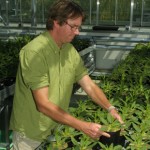
Ian Baldwin, Max Planck Institute for Chemical Ecology (MPICOE)
A native desert tobacco is revealing its secret weapons to chemist Ian Baldwin from the Max Planck Institute for Chemical Ecology (MPICOE) in Jena, Germany.
This tobacco responds to attack with a multi-layered defence system that recognises the different kinds of attackers and responds appropriately. Its battery of defences include toxins, such as nicotine and di-terpene glycosides, and digestibility reducers, such as proteinase inhibitors, that function as direct defences, as well as a battery of indirect defences, that betray the location of feeding herbivores to their own natural enemies.
Ian talks to the plant using gene technologies to determine what genes are switching on and off, what proteins the plant is making and how its metabolism changes. Ian believes that his approach will lead to new approaches to sustainable pest resistance for agricultural crops.
Abstract
Asking a plant and its natural herbivore community for new means of crop protection
I. T. Baldwin
Max Planck Institute for Chemical Ecology (MPICOE), Jena, Germany
Nicotiana attenuata is a native diploid tobacco that times its germination after fires in the Great Basin Desert of North America and thereby grows in the primordial agricultural niche. My Department at the MPICOE in Jena has been studying how this plant responds to attack from its native herbivore community so as to indentify new means of sustainable pest resistance for agricultural crops.
The research has uncovered a multi-layered defense system that involves complex signaling systems, capable of recognizing attack of individual taxa of herbivores which tailors defense and tolerance responses.
The defense response, which include increases in the production of a battery of secondary metabolites, that include toxins, such as nicotine and diterpene glycosides, and digestibility reducers, such as proteinase inhibitors, that function as direct defenses, as well as a battery of indirect defenses, that betray the location of feeding herbivores to their own natural enemies.
These defense responses are embedded in changes in source-sink relationships that reduce the fitness consequences of leaf removal for the plant, as well as changes in flower phenology that reduce future herbivore loads.
All of these responses were uncovered through an ask the plant experimental approach, in which the plant’s transcriptome, proteome, and metabolome were queried when the plant was attacked by different herbivores. Gene silencing procedures, involving both stable and transient gene silencing of plants grown in natural and semi-natural habitats were used to examine the relevance of the responses for the ecological interactions.
A similar experimental approach has been initiated to understand how adapted insect herbivores cope with the plants’ induced defenses, asking the herbivore’s transcriptome to reveal adaptive mechanisms, and testing the relevance of the transcriptional responses to herbivore resistance with plant-mediated RNAi approaches..
Photo: Danny Kessler

